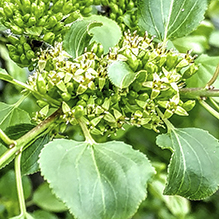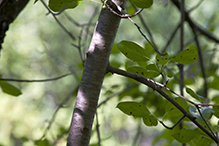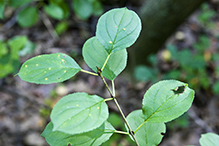common buckthorn
(Rhamnus cathartica)
Conservation • Weed • Wetland • Description • Habitat • Ecology • Use • Distribution • Taxonomy
Description |
||
Common buckthorn is usually a tall shrub, sometimes a small tree. It rises from a woody taproot on 1 or a few stems. It is moderately fast-growing, short-lived, 16′ to 25′ tall, and up to 5″ in diameter at breast height. The bark on young stems is smooth, thin, shiny, gray to reddish-brown, with numerous prominent, elongated lenticels. On older stems the bark is dark gray and scaly or peeling with curly edges, revealing orange inner bark. First-year twigs are slender, stiff, green to brownish-green, and hairless. Second-year twigs are brown with a gray, flaky outer layer. There is a thorn at the tip of many of the the twigs, giving this plant its common name. There are additional dwarf spur branches with a thorn at the tip. The thorns are between the last pair of lateral buds. Buds are about ¼″ long, egg-shaped, sharply pointed, reddish-brown to dark brown, opposite or almost opposite, and appressed to the twig. They are covered with a few distinctly overlapping scales. The scales have a margin of fuzzy hairs. The leaf scars are small, crescent-shaped, distinctly raised, and have 3 bundle scars. The leaves are deciduous and usually opposite or almost opposite, sometimes alternate. They are on hairy, ⅜″ to 1⅜″ long leaf stalks that are grooved on the upper side. The leaf blades are inversely egg-shaped to elliptical, 1½″ to 2⅜″ long, and ¾″ to 1½″ wide. They are rounded or tapered at the base and usually abruptly pointed, sometimes rounded, at the tip. There are 3 to 5 lateral veins on each side of the midrib. The veins are strongly curved, arching toward the tip. They are depressed on the upper side of the leaf and stand out on the underside. The upper surface of the leaf blade is medium green to dark green and hairless or nearly hairless. The lower surface is somewhat pale green and hairy or nearly hairless. The margins are finely toothed. The leaves stay green into late fall. The inflorescence is a stalkless, umbrella-like cluster (umbel) of 1 to 5 flowers rising from the leaf axils of the lower part of current year’s long twigs and from short spur branches. Male and female flowers appear on separate plants. The flowers are about ¼″ wide. They have 4 conspicuous, spreading, yellowish-green sepals and 4 shorter, inconspicuous, erect, green petals. Male flowers have 4 stamens, female flowers have 1 style. Each flower is on a ⅛″ to 5 ⁄16″ long, usually hairless flower stalk. They appear in mid-May to mid-June after the leaves have formed. The fruit is a berry-like, 3 ⁄16″ to 5 ⁄16″ in diameter drupe containing 3 or 4 seeds. It is green at first, eventually turning bluish-black at maturity. It matures in late August to late September and often remains on the twig long into winter. |
||
Height |
||
16′ to 25′ |
||
Flower Color |
||
Yellowish-green |
||
Similar Species |
||
Glossy buckthorn (Frangula alnus) has no thorns. The leaves are always alternate, never opposite or almost opposite. There are 6 to 9 straight, parallel lateral veins on each side that curve up near the margin. The upper surface is glossy. The margins are untoothed. The flowers and fruit are in clusters of up to 8. The fruit falls to the ground before winter. Gray dogwood (Cornus racemosa) has no thorns. The leaves are always opposite, not merely almost opposite. The leaf margins are untoothed. The flowers are white. The fruit and flowers are in dense clusters of 20 to 75 at the end of the stems. |
||
Habitat |
||
Wet to dry. Forests, thickets, hedgerows, pastures. Full sun to partial shade. |
||
Ecology |
||
Flowering |
||
Mid-May to mid-June |
||
Pests and Diseases |
||
Use |
||
|
||
Distribution |
||||
|
Sources |
|||
| 3/27/2023 | ||||
Nativity |
||||
Native to Europe, Asia, and northern Africa. Introduced as an ornamental shrub, escaped cultivation, and naturalized in North America. |
||||
Occurrence |
||||
Common and widespread |
||||
Taxonomy |
|||
| Kingdom | Plantae (Plants) | ||
| Division | Tracheophyta (Vascular Plants) | ||
| Subdivision | Spermatophytina (Seed Plants) | ||
| Class | Magnoliopsida (Dicots) | ||
Order |
Rosales (Roses, Elms, Figs, and Allies) | ||
Family |
Rhamnaceae (buckthorn) | ||
| Tribe | Rhamneae | ||
Genus |
Rhamnus (buckthorns) | ||
Subordinate Taxa |
|||
|
|||
Synonyms |
|||
Common Names |
|||
buckthorn Carolina buckthorn common buckthorn European buckthorn European waythorn Hart’s thorn purging buckthorn |
|||
Glossary
Axil
The upper angle where a branch, stem, leaf stalk, or vein diverges.
Calcareous
Alkaline; rich in limestone; containing a high proportion of calcium carbonate.
Drupe
A fleshy fruit with a single hard, stone-like core, like a cherry or peach.
Lenticel
A corky, round or stripe-like, usually raised, pore-like opening in bark that allows for gas exchange.
Sepal
An outer floral leaf, usually green but sometimes colored, at the base of a flower.
Umbel
A flat-topped or convex, umbrella-shaped cluster of flowers or buds arising from more or less a single point.
Visitor Photos |
|||||
Share your photo of this plant. |
|||||
| This button not working for you? Simply email us at info@MinnesotaSeasons.com. Attach one or more photos and, if you like, a caption. |
|||||
Barbara Dodge |
|||||
Very fragrant blossoms. |
|||||
 |
 |
||||
MinnesotaSeasons.com Photos |
|||||
Plant |
|||||
 |
|||||
Young Bark |
|||||
 |
|||||
Leaves |
|||||
 |
 |
||||
 |
|||||
Infructescence |
|||||
 |
|||||

Slideshows |
||

Visitor Videos |
|||
Share your video of this plant. |
|||
| This button not working for you? Simply email us at info@MinnesotaSeasons.com. Attach a video, a YouTube link, or a cloud storage link. |
|||
Other Videos |
|||
| The Invasive Species Hunter: Common Buckthorn ID DianaShermet |
|||
About
Published on Aug 27, 2012 Join Nate the Invasive Species Hunter as he looks for Southern Ontario's highly invasive species. He'll show you how to ID common buckthorn and explain some of the impacts these plants have on our biodiversity. Written and video taped by the Central Lake Ontario Conservation Authority in partnership with the Invading Species Awareness Program and the Ontario Invasive Plant Council. |
|||
| What is a Buckthorn? unclethomskitchen |
|||
About
Published on Jul 11, 2012 This is a intro to a show we are doing on the invasive Buckthorn tree. Buckthorn is taking over our forests, woods and even our yards. Stay turned for the whole story. |
|||
| Winter Buckthorn Identification TheJMPECrew |
|||
About
Uploaded on Feb 5, 2011 No description available. |
|||
| How to Identify Buckthorn in Winter PatrickDel1982 |
|||
About
Uploaded on Apr 11, 2007 This is a short educational video about how to identify buckthorn in the winter. |
|||
| Buckthorn: A Deadly Invasion PatrickDel1982 |
|||
About
Uploaded on May 26, 2007 Buckthorn slowly invades the Twin Cities areas, attacking its forests and spreading disease. An invisible massacre. |
|||

Visitor Sightings |
|||||
Report a sighting of this plant. |
|||||
| This button not working for you? Simply email us at info@MinnesotaSeasons.com. Be sure to include a location. |
|||||
| Barbara Dodge 5/29/2017 |
Location: Riverwalk, Lowertown, St. Paul Very fragrant blossoms. |
 |
|||
MinnesotaSeasons.com Sightings |
|||||
Avon Hills Forest SNA, North Unit Bertram Chain of Lakes Regional Park Carpenter St. Croix Valley Nature Center Charles A. Lindbergh State Park Clifton E. French Regional Park Clinton Falls Dwarf Trout Lily SNA Hardscrabble Woods / MG Tusler Sanctuary John Peter Hoffman Spring Brook Valley WMA Margherita Preserve-Audubon Prairie Mary Schmidt Crawford Woods SNA Minnesota Valley NWR, Chaska Unit Minnesota Valley State Recreation Area, Lawrence Unit Mound Spring Prairie SNA, North Unit Nerstrand Big Woods State Park Northern Tallgrass Prairie NWR, Hoffman Unit Northern Tallgrass Prairie NWR, Spieker Unit P.N. and G.M. Nelson Wildlife Sanctuary Prairie Creek WMA, Koester Prairie Unit Robert Ney Memorial Park Reserve Sand Prairie Wildlife Management and Environmental Education Area |
|||||

|
Created: Last Updated: © MinnesotaSeasons.com. All rights reserved. |
